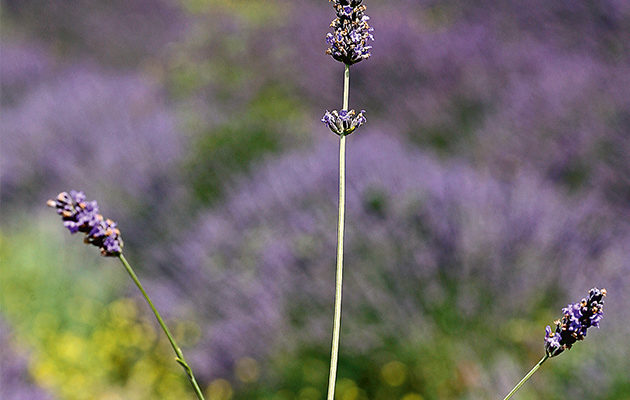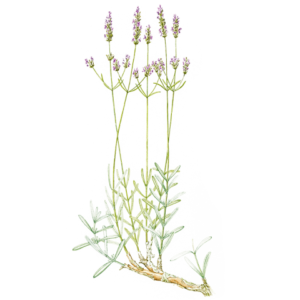
Find out more about the Spike lavender plant of our Aromatherapy Herbarium blog series.

SPIKE LAVENDER
Lavandula latifolia
(syn. Lavandula spica)
DESCRIPTION

Spike lavender (Lavandula latifolia) is a shrub thirty to sixty centimetres tall of the Lamiaceae family, it grows in the wild at an altitude below seven hundred metres on the arid and sunny hills of southern France and the Mediterranean area.
ADVICE
DO NOT USE IN
– pregnant or breast-feeding women,
– children under the age of six years (ketones),
– persons allergic to one of the components (geraniol, linalool, limonene),
– subjects with asthma without the advice of an allergologist before the first use,
– subjects with epilepsy (ketones).
RECIPES
Osteoarthritis
Place 3 drops of essential oil of spike lavender on the painful zone, three times daily for twelve days.
Burns
Apply 3 to 6 drops of pure essential oil of spike lavender on the skin, three or four times daily on the area concerned. If the burn just took place, repeat the application every fifteen seconds for ten minutes, then every fifteen minutes for two hours. The zone is large dilute 5 drops of spike lavender per 5 drops of St John’s wort carrier oil.
Dry or oozing eczema
Apply 2 drops of pure essential oil of spike lavender, two or three times daily on the irritated skin.
Otitis
Apply a few drops pure around the ear (warning, never in the ear canal) and repeat several times daily.
Chronic sinusitis
1 drop of EO of tea tree, 1 drop of EO of spike lavender.
Pour 2 drops on a neutral tablet, and take three times daily.

It is the last of all lavender species to bring to term its pale violet flowers.
A humble cousin of true lavender (Lavandula angustifolia), the French name, lavande aspic, is derived from its anti-venom property well known of hunters. They save their dogs bitten by a viper by harvesting a handful of flowers and rubbing the injured site. Spike lavender was probably the “rustic nard” of the Romans. It was of great help to the inexhaustible speakers of the Revolution since Lamarck states in his French flora, a brief description of all plants naturally encountered in France, from 1794, that “it is supposed to be good remedy for the loss of voice”.
CULTIVATION AND PRODUCTION
Spike lavender grows abundantly in the wild in Europe. The yield per hectare is very variable, ranging from fifteen to eighty kilograms depending on the plant, climate, region and age of the plantation. The best essential oil yield is obtained when the plant is four to six years old.
FRAGRANCE
The essential oil of spike lavender is darker than that of true lavender with a less suave fragrance. No one would think of perfuming their linen cupboard or custard with it, however this strong fragrance, due to the presence of camphor, seduces perfume makers.
EXTRACTION AND YIELD
The distillation of lavender for aromatherapy is performed by traditional steam distillation. The essential oil yield of spike lavender is of 0.5% to 0.8%, i.e. five hundred to eight hundred grams of essential oil per hundred kilograms of flower.
CHEMICAL FORMULA
The main active constituents of essential oil of spike lavender are monoterpenols (more than 40% linalool), terpenic oxides and ketones (camphor: 14%-15%). Camphor and eucalyptol are almost absent in Lavandula vera.
MAIN INDICATIONS
Spike lavender is anti-toxic, anti-infectious and exceptionally wound healer, a precious companion for the summer holidays. It is indicated for everything that stings: insects, jellyfish, sunburns. It exterminates mites and lice, and is also a remarkable fungicide eradicating the most recalcitrant mycoses (dermatological and athletes foot in particular, digestive or gynaecological). It is of great service in the ENT field, as it has an effective analgesic action, especially in case of Herpes zoster, herpes or joint or muscular pains (osteoarthritis, rheumatoid arthritis, cramps, etc.).


Leave a Comment